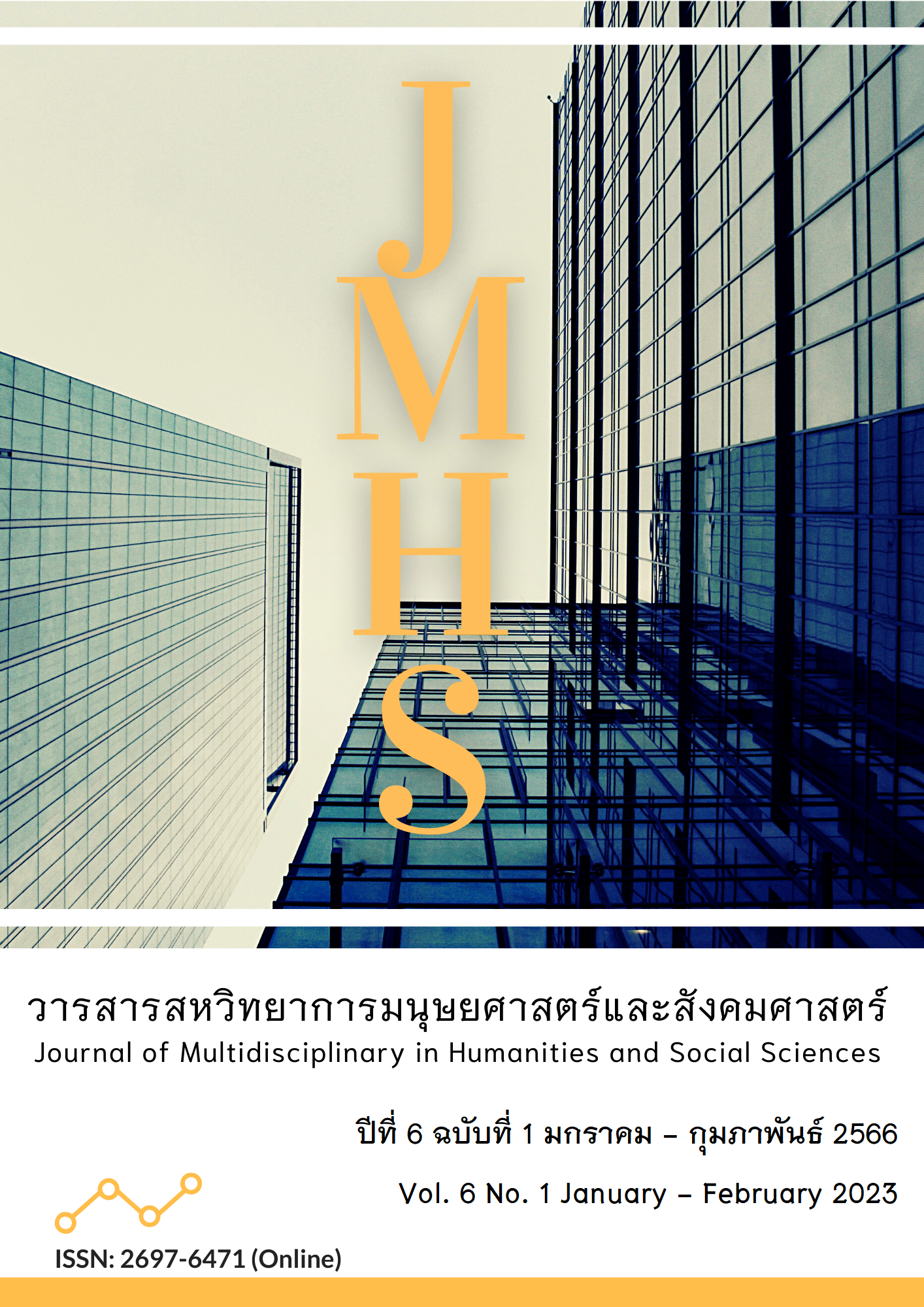People Awareness and Self-Prevention in Case of Flood in Pattaya City
Main Article Content
Abstract
This article has the objectives 1) to study the level of personal awareness of the people in Pattaya City in flood prevention, 2) to study the differences in the level of awareness classified by personal factors, and 3) to propose guidelines for promoting flood prevention. Awareness of the people in Pattaya City. The research model is quantitative research. Using the concept of measuring emergency awareness as a research framework, the research area is 5 communities: Soi 6Yossak, Central Pattaya, Khao Noi, Khao Talo and Chum Sai, Chonburi Province. The sampling group is people living in the area of Pattaya City in 6 flood-affected communities totaling 385 people. Use a convenient selection method and research tool was a questionnaire. The data was analyzed by descriptive data analysis. Hypothesis testing was performed using t-test and one-way analysis of variance. The level of statistical significance was set at 0.05. The results showed that firstly overall awareness was at moderate level (53.79%). Secondly, personal factors affecting self-protection against flooding of people in Pattaya City were age, education level, occupation, community, number of years living in Pattaya and channels for obtaining information about causes and prevention of flooding. Number of years living in Pattaya and channels for obtaining information about causes and prevention of flooding. And thirdly, Knowledge of town planning should be promoted. necessary equipment Tracking climate data Increase the number of volunteers and online medical channels. The knowledge gained from this research can be useful to the affected people in the area or in other areas of Pattaya City to study or learn more about issues with low scores. And Pattaya City can plan to solve the weakness issues.
Article Details

This work is licensed under a Creative Commons Attribution-NonCommercial-NoDerivatives 4.0 International License.
Views and opinions appearing in the Journal it is the responsibility of the author of the article, and does not constitute the view and responsibility of the editorial team.
References
กฤษณะ อิ่มสวาสดิ์. (2562). โครงการจัดการระบบระบายน้ำแบบบูรณาการเพื่อลดผลกระทบจากการเปลี่ยนแปลงสภาพภูมิอากาศและผลกระทบต่อชุมชนเมืองในพื้นที่เศรษฐกิจพิเศษภาคตะวันออก (รายงานวิจัย). คณะภูมิสารสนเทศศาสตร์, มหาวิทยาลัยบูรพา.
กรมป้องกันและบรรเทาสาธารณภัย กระทรวงมหาดไทย. (2557). การลดความเสี่ยงจากภัยพิบัติสู่การพัฒนาที่ยั่งยืน. กรุงเทพฯ: ชุมนุมสหกรณ์การเกษตรแห่งประเทศไทย.
จุฑารัตน์ เอื้ออำนวย. (2553). จิตวิทยาสังคม. กรุงเทพฯ: จุฬาลงกรณ์มหาวิทยาลัย.
ฐานเศรษฐกิจ. (2564). ผ่าเเผนแก้ปัญหาน้ำท่วมซ้ำซากเมืองพัทยา. สืบค้นจาก https://www.thansettakij. com/general-news/495758
ถวิล ธาราโภชน์ และ ศรันย์ ดำริสุข. (2543). พฤติกรรมมนุษย์และการพัฒนาคน. กรุงเทพฯ: ทิพยวิสุทธิ์.
ทนงศักดิ์ ประสบกิตติคุณ. (2534). การประเมินค่าความตระหนักในปัญหาสิ่งแวดล้อม ของนักเรียนชั้นมัธยมศึกษาปีที่ 3 จังหวัดตราด. กรุงเทพฯ: มหาวิทยาลัยเกษตรศาสตร์.
ไทยรัฐออนไลน์. (2564). น้ำท่วมพัทยา 2559-2563. สืบค้นจาก https://www.thairath.co.th/tags/%E0%B8%99%E0%B9%89%E0%B8%B3%E0%B8%97%E0%B9%88%E0%B8%A7%E0%B8%A1%E0% B8%9E%E0%B8%B1%E0%B8%97%E0%B8%A2%E0%B8%B2
บัณฑิต จุฬาศัย. (2528). เยาวชน ผู้กำหนดสภาวะแวดล้อมในทศวรรษหน้า. จุลสารสภาวะแวดล้อม.
ประสาท อิศรปรีดา. (2523). จิตวิทยาการเรียนรู้กับการสอน. กรุงเทพฯ: กราฟิคอาร์ต.
ฝ่ายทะเบียนและบัตรประชาชน สำนักปลัดเมืองพัทยา. (2561). สถิติประชากร จำแนกปี พ.ศ. 2560. สืบค้นจาก https://www.pattaya.go.th/document/บรรยายสรุป2561/(ตัวแทรกหน้า 87) สถิติประชากรชุมชน ปี 60.pdf
วัชรี คุณกิตติ, วิจิตรา ศรีสอน และ สัณฐาน ชยนนท์, 2563. รูปแบบความร่วมมือการจัดการภัยพิบัติทางธรรมชาติของไทยกลับกลุ่มประเทศอาเซียน. วารสารสังคมศาสตร์และมานุษยวิทยาเชิงพุทธ, 5(2), 167-177.
สำนักงานประกันสุขภาพแห่งชาติ. (ม.ป.ป.). การบริการสร้างเสริมสุขภาพและป้องกันโรค (P&P). สืบค้นจาก https://www.nhso.go.th/page/coverage_rights_health_enhancement
เว็บไซต์ Thai PBS. (2564). น้ำท่วมพัทยา 2559-2563. สืบค้นจาก https://www.thaipbs.or.th/search?q=%E0%B8%99%E0%B9%89%E0%B8%B3%E0%B8%97%E0%B9%88%E0%B8%A7%E0%B8%A1%E0%B8%9E%E0%B8%B1%E0%B8%97%E0%B8%A2%E0%B8%B2&type=&published_ range=&page=1
อุรารัศมิ์ บุรณศิริ, สันทัด ทองรินทร์, และ ศิริวรรณ อนันต์โท. (2557). การเปิดรับและการตระหนักรู้ของประชาชนเกี่ยวกับการสื่อสารแจ้งข่าวเตือนภัยน้ำท่วมในพื้นที่เสี่ยงภัยน้ำท่วม จังหวัดลพบุรี. นนทบุรี: มหาวิทยาลัยสุโขทัยธรรมาธิราช.
Centre for Research on the Epidemiology of Disasters. (2021). Disaster Year in Reviews 2020 Global Trends and Perspective. Brussels.
Enders, J. (2001). Measuring Community Awareness and Preparedness for Emergencies. Australian Journal of Emergency Management, 16(1), 52-58.
Good, C.V. (1973). Dictionary of Education. New York: McGraw-Hill.
Olaimat, A.N., Aolymat, I., Elsahoryi, N., Shahbaz, H.M., & Holley, R.A. (2020). Attitudes, Anxiety, and Behavioral Practices Regarding COVID-19 among University Students in Jordan: A Cross-Sectional Study. Am J Trop Med Hyg. Sep, 103(3), 1177-1183.
Pratkanis, A.P., Breckler, S.J., & Greenwald, A.G. (1989). Attitude Structure and Function. New York: Lawrence Eribaum Association.
Rokeach, M. (1968). Beliefs, Attitudes and Values. San Francisco: Jossey Basso.
United Nations International Strategy for Disaster Reduction (UNISDR). (2010). Local Governments and Disaster Risk Reduction Good Practices and Lessons Learned a Contribution to the “Making Cities Resilient” Campaign. Geneva, Switzerland: United Nations.


